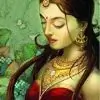Sita did not spring into existence with the Ramayana. In fact, She predates that epic by a millennium or so, making Her earliest known appearance in the Rig Veda, where She is worshiped in several hymns as an agricultural and fertility deity. The Kausika Sutra also identifies Her as "mother of gods, mortals, and creatures," and equates Her with intelligence, growth, increase and prosperity. "Sita literally means 'furrow,' as in a ploughed field, or the parting of the hair on the head; it also implies the female vaginal furrow as the source of life." Vedic writings "show that She was worshiped as a goddess, the furrow personified." She is a Goddess who connects the fecundity of the earth with the eternal divine; and no doubt Valmiki had these powerful associations in mind when he described Her extraordinary birth in the Ramayana.

Sita Devi as Goddess of Fertility
Sita's ancient associations with fertility and the Earth are continually echoed throughout the Ramayana. Plants and animals constantly reflect Sita's actions and moods. As the very essence of Prakriti, or Nature, Sita does not find Her jungle exile fearful: "Just as Sita used to delight in going through the city parks, so is She now content in the forest solitude." At one point, when Sita makes a sacrificial offering under a "green-leafed Nyagrodha tree," all growing plants are brought to Her for inspection . In general, Sita is presented as if She were truly the mistress of vegetation."
Goddess Sita with Lord Ram and Lord Lakshman showering love on other creatures.
When Sita is kidnapped by Ravana, the forest itself reflects Her absence. as Rama surveys the spot from which She had been abducted -- "the trees nearby that seemed to be weeping, the melacholy birds, miserable deer, and faded flowers ..." Similarly, while in captivity, Sita literally begins to wilt like a flower deprived of its sap; at one point She is described as "a lotus pool stripped of its flowers" But when She returns to Ayodhya, "fruitless trees became fruitful; trees without flowers abounded in blossoms; those that were withered sprouted leaves, and the foliage dripped honey."
Sita has an similarly powerful effect on animals, another aspect of Nature: When She leaves Ayodhya, elephants and cows cease to perform their functions ; when She is kidnapped, lions and tigers follow Her shadow , a vulture tries to rescue Her , deer show Rama the direction in which She was taken , a crow keeps them on the right path , and an army of monkeys (led by the great God Hanuman) and bears helps Rama to defeat Ravana and rescue Her.
SITA AS UPHOLDER OF COSMIC ORDER
Shaktism -- and many non-Shakta schools of Hinduism -- associate Devi, the Goddess, with cosmic order. Countless legends, most prominently those associated with Durga in the Devi Mahatmyam, or with various other Goddess forms in the Devi Bhagavata Purana, depict Her as the force the Gods turn to when Universal Order is threatened by the forces of Chaos. Now, Sita is clearly no avenging warrior goddess like Durga or the Matrikas -- but a close reading of the Ramayana clearly reveals that Creation would unravel without Her.
Sita as independent Goddess
This aspect of Sita can also be traced back to the Vedas, which contain a primary source for the Ramayana.
In the Ramayana, where Ravana, by kidnapping Sita, has "obstructed the growing processes of Nature by confining their source.That Her death would mean the end of the world is echoed in Rama's expressions of despair at the thought of Her loss." And Ravana states that one of his principle motivations for kidnapping Sita is his knowledge that "Rama will not survive without Sita."
Indra comes to Earth with his wife to feed Sita
Rama reveals what is Sita to him
Indeed, the Ramayana itself refers to Sita at several points by the epithet, Ardhangini, "the half-body of Her husband" -- recalling the perfect Yin-Yang equality of Parvati and Shiva in the form of Ardhanarishwar/Ardhanarishwari -- and the overall sense of the text suggests that "Rama and Sita are to be regarded as one being, Her virtue the source of His power."
Indeed, Rama Himself declares: "Sita is to me what light is to the sun. ... I can no more forsake Her than an honorable man can renounce his honor."

And so Sita -- Earth Goddess, Fertility Goddess, Upholder of Cosmic Order, and Shakti -- when joined with Her masculine half, Rama, contributes Her divine power to His realm as devoted consort. United with the Hero/God, the Goddess Sita -- like all forms of Devi -- becomes the source and support of the ongoing prosperity of the world that is symbolized in the Rama's divine, 10,000-year rule.
Goddess Sita Meditating
Sita-focused manuscripts of the Ramayana tend to come from the traditional Shakta strongholds in the East and South of India. As N.N. Bhattacharyya writes in his "History of the Sakta Religion":
"It is interesting to note that in the Adbhuta Ramayana, a late work highly favoured by the Kashmirian Shaktas, Sita is stated to have killed Ravana [by] assuming the form of Kali. The said work identifies Sita with the Supreme Being of the Shaktas. The [practice] of associating Shaktism with Rama-Sita legends may be traced even to the Sanskrit Ramacarita of Abhinanda, which is a work of the tenth century. ... [And] in Sarala Dasa's Oriya Ramamyana, the tradition of the Adbhuta Ramayana is followed, in which Sita herself killed Ravana in the form of Bhadrakali. The story of the slaying of Ravana by Sita is also found in the Jaiminibharata and other later Bengali Ramayanas. According to the popular Rama legends of the Mathura region, it was Sita who killed Ravana and, having accomplished the task, went straight to Calcutta instead of Ayodhya and settled there permanently as Kali Mai."
Hope you find this post informative and interesting friends,please comment if you like it.
Thank You!
































